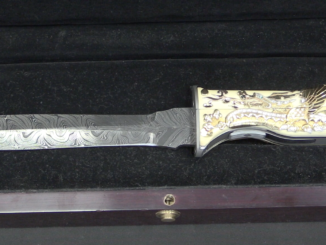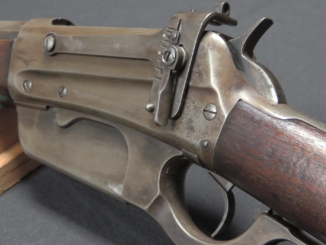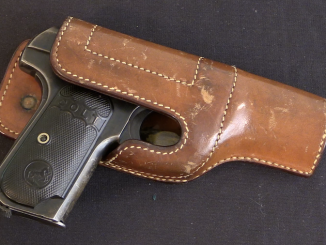One of many firearms developed for Remington by Joseph Rider was the Rider Magazine Pistol – a manually operated 5-shot repeater chambered for the .32 extra-short rimfire cartridge (the same round used by the Chicago Palm Protector). It used a tube magazine under the barrel and a simple but clever vertically shifting breechblock to give an impressive amount of firepower in small (and particularly flat and narrow) package. About 15,000 of these were made between 1871 and 1888, and they represent one of the few American uses of a tube magazine in a handgun – a combination more popular in Austria (and which was instrumental in the development of semiautomatic handguns there).
Related Articles

Combination gun
The Most Ornate Knife-Gun You Will Ever See: CM-1 “Dragon”
Combination knife-gun devices have been popular for hundreds of years, spurred initially by the single-shot nature of early firearms. The designs evolved to incorporate revolver cylinders when the revolver was invented, and remain interesting to […]

Lever Action Rifles
Winchester Lever Action Development: Model 1895
Carbine Rifle We have reached the final iteration of the Winchester lever action rifle development story today, the Model 1895. This was another John Browning design, although the locking system is basically the same as […]

Accessories
Audley Safety Holster and an OSS Colt 1903
F.H. Audley was a saddler who ran a business in New York City starting in the 1870s. As his business in horse tackle declined with the spread of automobiles, he found himself looking for other […]

” same round used by the Chicago Palm Protector”
Municion has shows center-fire cartridge for said weapon:
http://www.municion.org/protector/protector8.htm
so it can not be same as (rim-fire) .32 Extra Short
And .32 Extra Short RF in municion:
http://www.municion.org/32Rf/32ExtraShort.htm
I have a Smith and Wesson Model 1 1/2 tip-up revolver in .32 rim fire. Is that the same as the .32 Extra Short rim fire that you mention here for the Remington? Both pistols are of the same vintage so it seems plausible.
No. The S&W 1 1/2 was chambered for the standard .32 Short rimfire, also used in the S&W Model 2, the Colt New line pocket revolver in .32, and various cheap spur-trigger “Suicide Special” SA revolvers of the time.
The two rounds (.32 Extra Short and .32 Short) were “one-way” interchangeable, in that the .32 ES had roughly the same dimensions as to rim, case head diameter, and bore as the .32 Short. But the cases were of two different lengths, .398″ for the ES, .575″ for the S. Cartridge OAL was different, too, the .32 ES being .645″, the .32 Short .948″.
In “short”, you could fire .32 Extra Short rounds in a .32 Short revolver, the same way a .22 Short or CB cap works in a .22 Long/Long Rifle-chambered arm.
But the .32 Short would not have worked in a .32 Extra Short-chambered weapon like the Rider or the Protector. Especially not the latter, where the cartridges are arranged like the spokes of a wagon wheel. You probably wouldn’t even be able to get the “wheel” back in the case.
cheers
eon
“.32”
There is query .32 rimfire in Wikipedia
https://en.wikipedia.org/wiki/.32_rimfire
stating that .32 rimfire exist in following versions:
EXTRA SHORT
SHORT
LONG RIFLE
EXTRA LONG
“the same way a .22 Short or CB cap works in a .22 Long/Long Rifle-chambered arm.”
To be exact there exist fire-arms that will act like this and exist such which will not.
For example Winchester Model 1890, each example was made for specific .22 cartridge.
And I suspect that Winchester Model 63 might give lower reliability if used with CB cap than with .22 Long Rifle, though statistical evidence I don’t have.
The action seems reminiscent of the Winchester 62 rifle.
A clever design at threshold of auto feeding. A step forward and there it happens the first sample of lever delay mechanism. What a fertile mind.
“What a fertile mind.”
For patent for that fire-arms see Patent US118152A:
http://www.google.com/patents/US118152
Thanks Daweo. I had found and rewieved it before my post.
Ok, here I’m dealing with one I’ve only seen in books. As such, I have a question.
Did the breechblock have to be pushed forward into battery before the trigger could be pressed to release the hammer to fire the piece? Or could it be fired by simply pressing the trigger and letting the hammer spring’s pressure “slap” the breechblock forward into battery fractionally before the hammer hit the firing pin hard enough to fire the cartridge?
I ask because I’ve seen it described both ways in different references. The “do it manually” method seems the most logical, being basically the manual of arms of Rider’s rolling block rifle. However, this would also seem to slow down the rate of fire, which is probably not a good thing in a CQ defense arm, especially one firing a pretty weak cartridge that would almost certainly need multiple hits to get the job done.
The “slapped forward” method would seem to be the one giving the highest RoF, which would be consistent with the up-close-and-personal defense mission. However, I’d suspect that such a maneuver, even if made possible by the action design, would carry a risk of breech failure at some point. In fact, I’m wondering if this trick might be the result of some wear in the mechanism to begin with. like a worn or broken disconnector, for instance, if it even has one.
I noticed that the upper “finger” on the lifter works a lot like the “spring finger” atop the breech of a Spencer repeater. There only being so many ways to keep the round being fed in an action like this “going the right direction”.
I class the Rider as an interesting gadget. But for deep-concealment point-blank defense at that time, something like the Remington Double Derringer, a Sharps four-shot, or the Chicago Protector palm pistol would seem more reasonable.
Just IMHO.
cheers
eon
The “slapped forward” method seems improbable. The breech block has to rise when it gets fully forward to lock, so there would have to a stand off between the hammer and breech block to keep the hammer mounted firing pin from setting off the round. Once the breech block rises there wouldn’t be enough hammer throw to reliably set off the primer.
What I wonder is how much time Mr. Rider spent adapting a tube magazine to the rolling block rifle. The thought must have crossed his mind. It could have been famous. 🙂
Since the breech block is returned forward by spring pressure, no need to do it manually. Should it not go fully into battery a nub on the trigger ensures that it is fully locked.
“Remington Double Derringer, a Sharps four-shot, or the Chicago Protector palm pistol would seem more reasonable.”
Rider has also designed more classic fire-arm of that era – revolver, see patents for Rider Pocket Revolver here:
http://www.american-firearms.com/american-firearms/z-html/company-E/E.%20Remington%20&%20Sons/E.%20Remington%20&%20Sons.html
The TV westerns of the Fifties and Sixties had a tradition of signature weapons for the hero, a tradition continued with Dirty Harry’s .44 Magnum. This Remington-Ryder pistol would have been just the ticket for that tradition. I can’t imagine that the .32 Extra Short Rimfire would have been billed as “the world’s most powerful handgun” or that it would be a precision weapon that would out-shoot riflemen, but it is an interesting piece.
Hideout weapon for Miss Kitty?
😉
cheers
eon
Maybe. I’d think more likely to be stashed in a gentleman’s vest pocket.
“Say hello to my little friend!” I suppose a contender for more ridiculous gentlemanly weapons would have been a Volcanic pattern pistol with metallic cartridges.
“The TV westerns of the Fifties and Sixties had a tradition of signature weapons for the hero, a tradition continued with Dirty Harry’s .44 Magnum.”
Heroes have their own weapons from time so long ago, so probably no-one could point who was first, take for example Skofnung:
https://en.wikipedia.org/wiki/Skofnung
Wow, what a cool little pistol. I wonder what it would be like in a modern version chambered in .32 ACP or .380 ACP…
It would have a much lower capacity? The .32 Extra Short cartridge was shorter in overall length than .22 Short…
http://www.municion.org/ give following overall length (mm):
.32 Extra Short RF – 16,10
.32 Auto – 24,93
.380 Auto – 27,96
Assuming same fixed magazine then you need multiply count of .32 Extra Short RF by:
0.65 to get number of .32 Auto
0.58 to get number of .380 Auto
cartridges
If .32″ and .380″ stand for .32ACP and .380ACP, are you sure about the correct lenghts ?… These two rounds are almost in the same lenght and .32ACP measures some 1mm longer sometimes.
My fail, .380 Auto should be 24,88, unintentionally I check overall length for .380 Short or 9x17R (revolver cartridge). Thus for both you need to multiply 0.65
CIP specification gives exactly 25mm as the maximum allowed overall length for both 7.65 Browning and 9mm Browning Short. So, in practice the same as municion.org.
The .32 Extra Short didn’t have a lot of power either out the muzzle or at the shooting end. The larger .41 rimfire from a Remington Double Derringer shot a 130 grain bullet at 425 feet per second for a whopping 52 foot pounds muzzle energy–when developing the Claymore Mine, the US Army specified a minimum 58 foot pounds energy for the mine fragments at impact distance–that was the minimum energy the US Army regarded then as sufficient to inflict an incapacitating wound. The .32 Extra Short couldn’t have been more capable than the .41 Rimfire.
As for the .32 ACP and .380 ACP, look up derringers and tiny pocket pistols made for them. The Kel Tec P-32 fires the .32ACP generating between 65 and 90 foot pounds muzzle energy (short barrel doesn’t permit the little 60 to 73 grain projectiles to generate maximum velocity) but recoil in that 6.6 ounce pistol is mild. However, the P3AT fires the more potent .380 ACP and recoil in that little 8.8 ounce pistol is painful.
I had a .22 LR derringer for a while and had to get rid of it because sometimes that little pistol would fly out of my hands under recoil–there was very little grip to hold on to.
“.32 ACP and .380 ACP, look up derringers and tiny pocket pistols made for them”
Which were introduced earlier than you can think, see for example Die Mann-Pistole:
http://unblinkingeye.com/Guns/Mann765/mann765.html
Now it is often dubbed Mann 7,65 to disguise from earlier Mann 6,35 automatic pistol, both of that pistol used groove in chamber for “gripping” case. Mann 7,65 also can be found in 9×17 Kurz (.380 Auto) version, but is rarer, hence it is dubbed 7,65. Mann 7,65 was introduced to market in 1920s.
And there was even earlier “BAYARD”-Selbstlade-Pistole:
http://unblinkingeye.com/Guns/Bayard/bayard.html
which was introduced before First World War. Similar to Mann it has 7,65 (.32 Auto) and 9×17 (.380 Auto) versions.
And there was Frommer Baby, a pocket version of Frommer Stop:
http://hungariae.com/FromBaby.htm
which also was introduced before First World War, and also has .32 and .380 version, though it use heavier-loaded version of these rounds.
–
Notice that all these (Mann 7,65 – Bayard – Frommer Baby) were made in 3 different countries (Germany – Belgium – Austria-Hungary)
And (after looking into Zhuk’s book) there was Bronco Model 1918 automatic pistol, made in Spain, for 7,65 mm Browning (.32 Auto), see 2nd and 3rd photo from top here:
http://www.carbinesforcollectors.com/blue13.html
With overall length 5.1″ it is similar to some .25 automatic pistol of that era.
Zhuk’s book show several “copies of Browning” in section AutomaticPistols/Spain which he divided into that firing 6,35 and 7,65. Interestingly there is not “9×17” section, so apparently at that time 7,65 was much more popular with Spain makers that 9×17.
Another Spanish made small 7,65 is Armero Especialistas Omega automatic pistol, see photos here:
http://www.rockislandauction.com/detail/1025/4350/two-spanish-semi-automatic-pistols
Though I was unable to found data about its overall length or mass
And you can see Browning’s knock-off from Zhuk’s here:
http://www.earmi.it/armi/atlas/237.htm
37 is code for “AutomaticPistol/Spain”
7.65 automatic pistols starts from 37-236, click Tavola successiva to go further. Omega for which I linked photo is 37-294
And there was Czechoslovak Mars automatic pistol for 7,65, see 50-19:
http://www.earmi.it/armi/atlas/278.htm
I was unable to get reference other than Zhuk (which give its overall length as 124 mm, barrel 64 mm, mass 465 g and capacity 6) because it is overshadowed by other automatic pistol named “Mars” also in 7,65 also made by this manufacturer (drawing 50-20 in link)
Modern .22 Short will develop about 35 ft•lbf of muzzle energy from a 1″ barrel such as the NAA Mini revolver, and that has been proven to be quickly lethal, if the heart or head is hit. This we know both from tests (it will pierce the adult skull or equivalent quite well at 3 feet) and real life examples (there is at least one example where an assailant was killed with the NAA Mini through the heart).
Incidentally, some European sources consider 40 joules or 15 ft•lbf as potentially lethal energy for a bullet (i.e. a relatively light but fast projectile). For low velocity but high but sectional density projectiles (arrows, throwing knives etc.) the limit is probably even lower.
Now, the much more elusive “stopping power” is a completely different matter. I don’t have ballistics for the .32 Extra Short, but it could very well be quite similar to modern .22 Short. Historical .22 Short was of course less potent since it was loaded with black powder. All I know is that I wouldn’t want to be shot with either one even with a full surgical trauma team waiting in the next room…
Oops, conversion error: 40 Joules is actually 29 ft•lbf.
Also if even low-power bullet will not cause death, it might have deterrent effect
Do lethal wounds with .22 Short include getting shot through the subclavian artery? Critical damage to the shoulder joint can cause nearly instantaneous death. I could be wrong but Watson got lucky in that he didn’t die…
One of the great Hollywood myths is that a hit to the shoulder or leg is “just a flesh wound”. Well, maybe if it misses the bone and the arteries, but a bullet that hits the subclavian, or the femoral artery in the leg, can mean death from internal hemorrhage in under five minutes.
I’ve always suspected that Murray, Watson’s orderly, must have done some fast and furious wound-packing to keep the good Doctor from bleeding out before (probably) getting him on a litter and out of the range of more Jezail-armed Pathans.
cheers
eon
If Watson were a real person instead of fictional character, I seriously doubt he could have survived a completely severed subclavian artery. Late 19th century field surgery just couldn’t repair such an extensive damage fast enough. We can explain that perhaps the artery was just nicked rather than severed.
Conan Doyle, after all, was not a surgeon but a regular physician. His specialties were neurology and ophthalmology. He did serve as a volunteer doctor in a field hospital for a few months, but as far as I know he performed no major surgeries and certainly not in field conditions.
It CAN be quickly lethal in the same way I can roll a six on the first throw of the dice. Neither the .22 Short nor the dice is RELIABLE. Besides which—for the 100th time—lethality is not the desideratum in a handgun cartridge. Incapacitation due to shock or pain is. I was accidentally shot in the thigh with a .22LR and did not notice till my leg (in dark pants) started feeling wet. A modest cramp set in a few minutes later. Pain enough to inconvenience took about 20 minutes
You sir are man of steel.